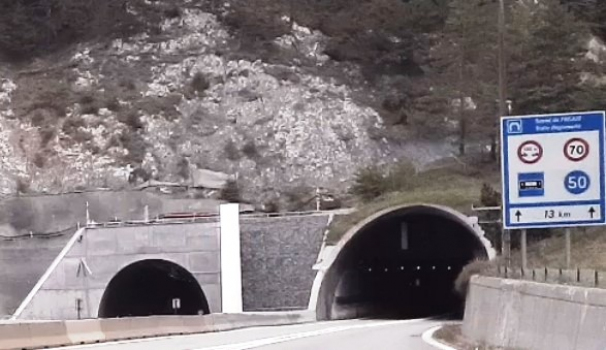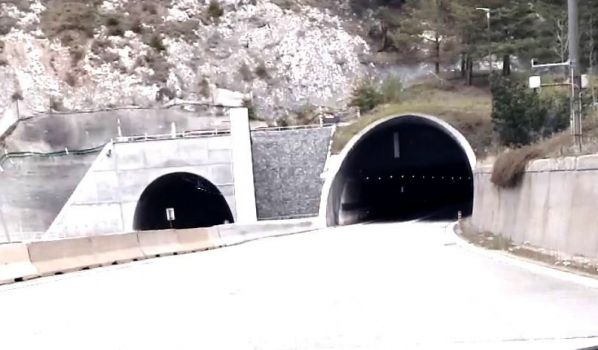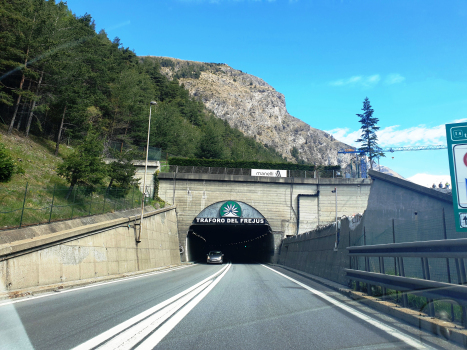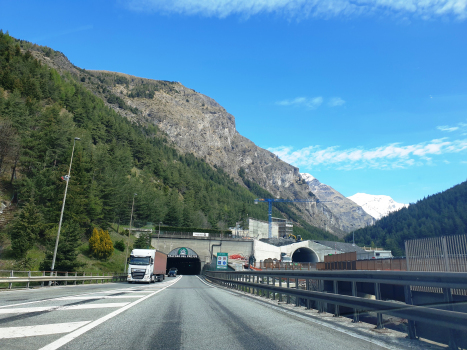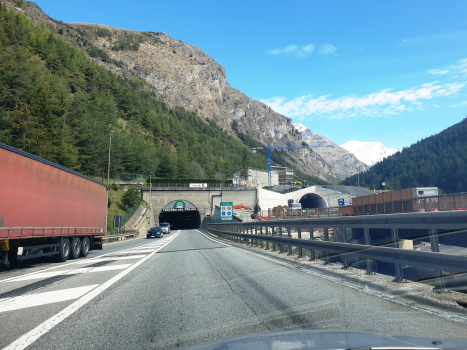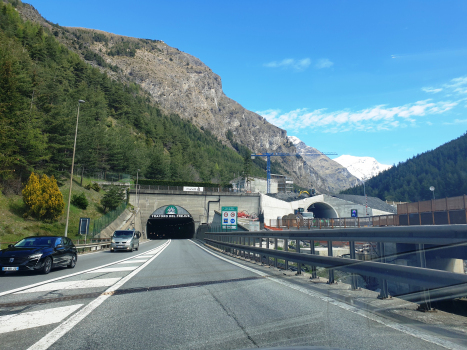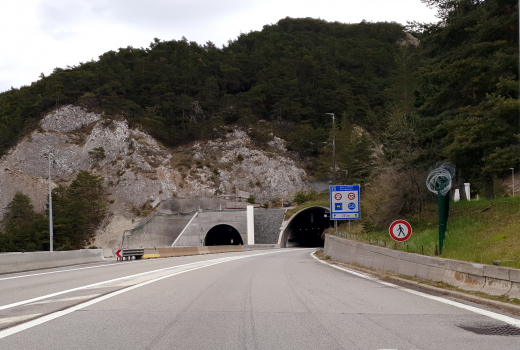General Information
| Name in local language: | Traforo stradale del Frejus; Tunnel routier du Fréjus |
|---|---|
| Beginning of works: | 1974 |
| Completion: | 1980 |
| Status: | in use |
Project Type
| Structure: |
Tunnel |
|---|---|
| Function / usage: |
Road tunnel |
Location
| Location: |
Modane, Savoie (73), Auvergne-Rhône-Alpes, France Bardonecchia, Torino, Piedmont, Italy |
|---|---|
| Address: | T4 - N543 |
| Through: |
|
| Next to: |
Fréjus Road Tunnel (2024)
|
| Coordinates: | 45° 11' 45.13" N 6° 40' 38.99" E |
| Coordinates: | 45° 5' 12.08" N 6° 42' 47.96" E |
Technical Information
Dimensions
| total length | 12 868 m |
Cost
| cost of construction | French Franc 2 000 000 000 |
Chronology
| 5 June 2005 | Two trucks catch fire in the tunnel causing the death of the two truckers. Due to possible structural damaged caused by the high temperatures, the tunnel is closed indefinitely until the actual damage has been determined and repaired. |
|---|---|
| 4 August 2005 | The tunnel is reopened after repairs are completed. |
Excerpt from Wikipedia
The Fréjus Road Tunnel is a tunnel that connects France and Italy. It runs under Col du Fréjus in the Cottian Alps between Modane in France and Bardonecchia in Italy. It is one of the major trans-Alpine transport routes between France and Italy being used for 80% of the commercial road traffic.
Construction of the 13 km (8.1 mi) long tunnel started in 1974, and it came into service on 12 July 1980, leading to the closure of the motorail shuttle service in the Fréjus rail tunnel. It cost 2 billion francs (equivalent to €700 million at 2005 prices). It is the thirteenth longest road tunnel in the world.
The French section is managed by the French company SFTRF, and the Italian section by the Italian company SITAF. (The French politician Pierre Dumas was chairman of SFTRF from 1962 to 1989). The tunnel can be reached from the Italian side by the A32 Torino-Bardonecchia motorway, or by SS335 from Oulx, which joins SS24 (“del Monginevro”), and reaches Bardonecchia after 20 km (12 mi). From the French side, it can be reached by the A43 (“l’Autoroute de la Maurienne”) from Lyon and Chambéry. A toll is charged to all traffic. Over 20 million vehicles passed through the tunnel during the first 20 years.
Safety
Following a major fire in the Mont Blanc tunnel in 1999, measures were taken at the start of 2000 to improve safety in the tunnel. A strict 70 km/h (43 mph) speed limit, and a safe distance of 150 m (160 yd) between vehicles was imposed. The tunnel was equipped with the latest smoke and flame detectors, and a system of videocameras in the tunnel to detect the speed of traffic, as well as fire and smoke. Temperature sensors were installed at short distances throughout the tunnel, monitored from a central control post. Fire hydrants were installed every 130 m, fed from large water tanks. There are 11 safety points along the tunnel, equipped with telephones and loud speakers connected to the control room, with a separate ventilation duct to supply fresh air. These are separated from the main tunnel by two fire doors; the outer door closes automatically when the temperature in the tunnel reaches a certain level. Finally there is a ‘thermal gate’ system at each entrance to identify any overheating vehicles.
Despite these measures, on 4 June 2005, a fire caused the death of two Slovak lorry drivers, and the closure of the tunnel to traffic for several weeks. It reopened to cars on 4 August 2005, and later to commercial vehicles. The tunnel was also briefly closed due to non-fatal fires on 9 January 2007, 29 November 2010, and 10 April 2014.
A second bore, parallel to the existing one at a distance of 50 m (55 yd), is under construction. Work began in 2009, following EU regulations put in place after the Mont Blanc Tunnel fire. Originally planned as an 8 m (26 ft) wide rescue tunnel, an agreement was reached in 2012 to open the new bore to traffic towards France while converting one lane of the existing bore into an emergency lane. The breakthrough occurred on 17 November 2014. The new bore is due to open to traffic in the autumn of 2023. As there will still be a single lane for each direction (the other lane being an emergency lane), the capacity of the tunnel will remain unchanged. Both bores will be connected by a series of passages, five of which can be used by emergency vehicles.
The firefighting team consists of four intervention teams: positioned on the Italian and French sides, and two inside the tunnel, about 4 km (2.5 mi) from each end.
Fréjus Underground Laboratory
Near the midpoint is the Laboratoire Souterrain de Modane (also referred to as the Fréjus Underground Laboratory). This site houses the Neutrino Ettore Majorana Observatory (NEMO experiment), an international collaboration of scientists searching for neutrinoless double beta decay. An observation of neutrinoless double beta decay would be evidence that neutrinos are Majorana particles and could be used to measure the neutrino mass. Attempts are underway to build a larger laboratory, either in the same tunnel or in the even deeper Lyon Turin Ferroviaire 15 km to the east.
Text imported from Wikipedia article "Fréjus Road Tunnel" and modified on June 5, 2024 according to the CC-BY-SA 4.0 International license.
Participants
- Fougerolle
- Omnium d'entreprises Dumesny et Chapelle
- PP-Setrac
- SFEDTP
- SGE Société Générale d'Entreprises
Relevant Web Sites
Relevant Publications
- (2005): L'accident du Fréjus relance le débat sur la sécurité et sur le ferroutage (déroulement de l'accident du 4 juin). In: Le Moniteur des Travaux Publics et du Bâtiment, n. 5298 (10 June 2005), pp. 18.
- (2019): L'avanzamento dei lavori della galleria di sicurezza del Frejus. In: Strade e Autostrade, v. 23, n. 134 (March 2019), pp. 110-112.
- (1981): Les équipements du tunnel alpin du Fréjus. In: Travaux, n. 551 (January 1981), pp. 56-62.
- (2014): The Fréjus rescue tunnel / Rettungsstollen Fréjus. In: Geomechanics and Tunnelling, v. 7, n. 6 ( 2014), pp. 685-692.
- Ouverture à la circulation du tunnel du Fréjus (8 juillet et 4 août 1980). In: Travaux, n. 545-546 (July - August 1980), pp. 78.
- About this
data sheet - Structure-ID
20004244 - Published on:
11/07/2002 - Last updated on:
20/05/2024

